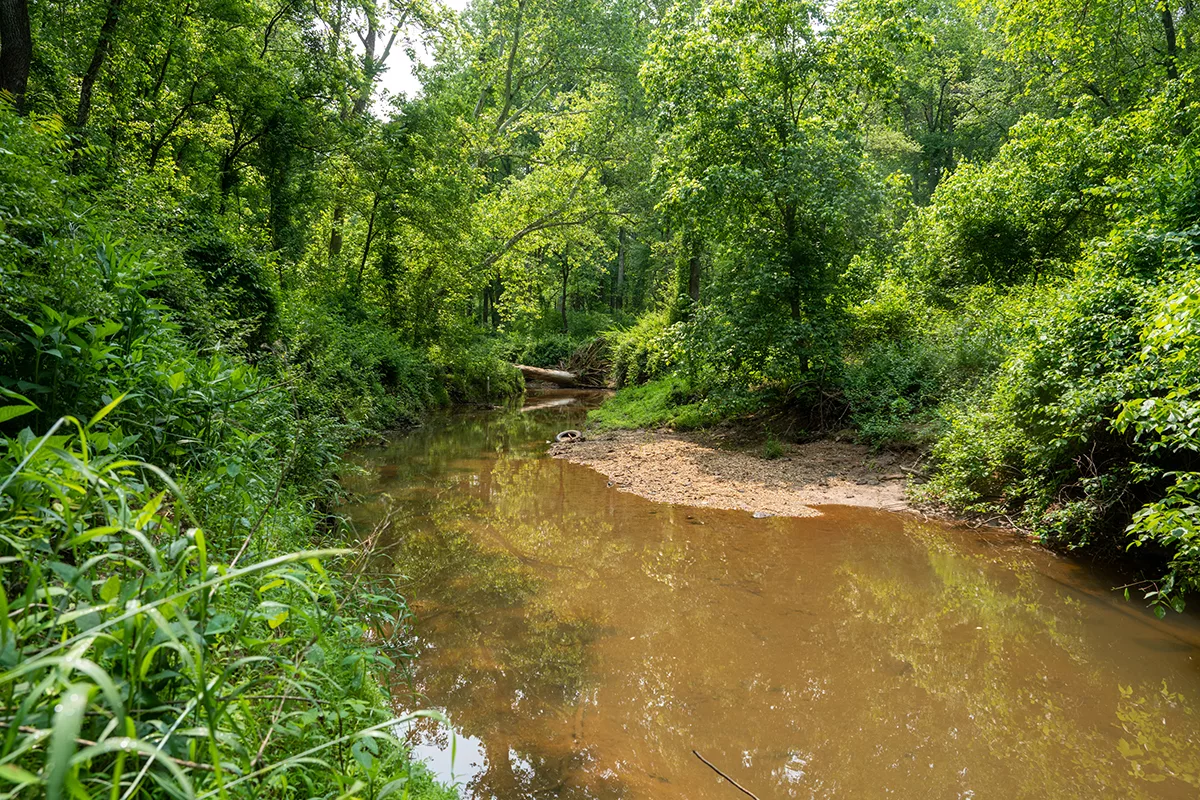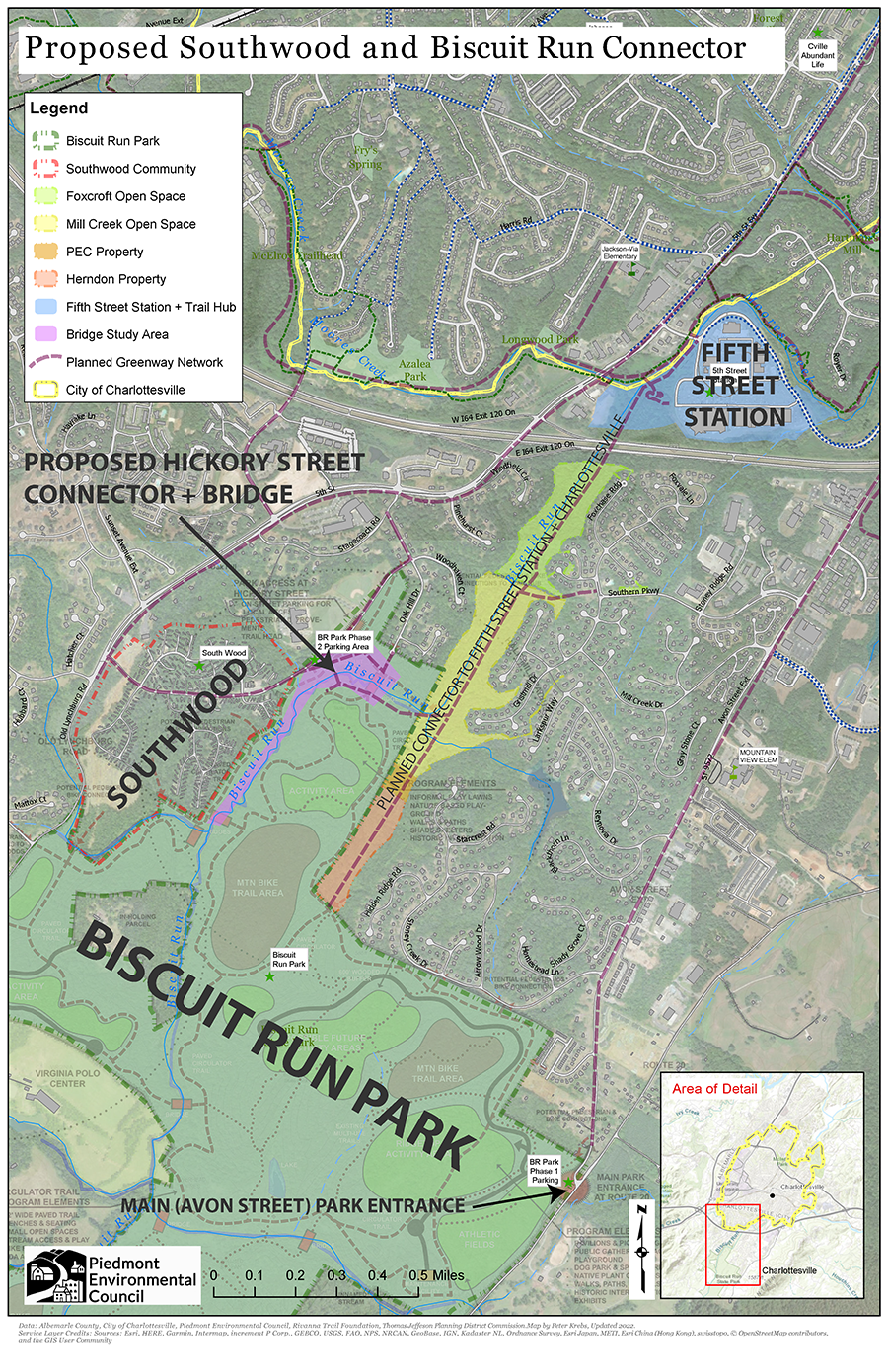When I was a child, I loved the woods behind my house. I played in streams, chased friends through the forest, discovered tiny hidden treasures and acquired a sense of awe within a cathedral of mighty trees. It was a space where I could grow and discover the world around me. Today, we know that playing in nature is linked to many educational and life-long benefits and that people of all ages are healthier and less stressed when they have ready access to trees and open space. That’s why I am so passionate and relentless about promoting everyday access to the outdoors for all and what drives my latest advocacy work with PEC.
My childhood woods were in an area similar to many neighborhoods in and around Charlottesville. What seemed at the time like a realm of infinite possibilities was actually a 15-acre county park — something I believe every child ought to have access to. So when I joined PEC back in 2017 and Biscuit Run Park was starting to look like a real possibility for Albemarle County, my mission was clear: We had to get it open and connected to as many people as possible.

At 1,190 acres of woodlands and fields, Biscuit Run Park is vast — nearly three times the size of other large county parks. Its landscape has forests, meadows, streams and ponds that will be kept close to their current state. Best of all, it is located next to neighborhoods where thousands of people live, work and go to school. Getting the park open hasn’t been simple, but thanks to the persistence of many people both inside and outside local and state government, we’re almost there. A soft-opening is scheduled for this fall, and the first wave of construction for parking, trails, and maintenance facilities should be substantially complete in spring 2024.
But will it be truly accessible to all? Will kids be able to run out their doors into that wooded sanctuary the way I did? That’s my next advocacy project with PEC.
Where Equal Access, Environmental Best Practice, and Cost-Savings Intersect
The initial entrance into Biscuit Run Park will be on its eastern extremity, on Virginia Route 20, and only accessible by car. On the park’s western border, the highly eroded Biscuit Run stream channel is extremely difficult to cross, making the park inaccessible by foot for the thousands of people who live nearby. Of particular concern is the Southwood community, the area’s largest concentration of affordable housing and where Habitat for Humanity of Greater Charlottesville is working with residents to create up to 1,000 homes, many of which will be deeply
affordable.
Biscuit Run Park is going to be a magnificent resource, and it wouldn’t be right for people of this community to be able to see the park, but not get to it easily. The park’s western entrance is planned as a bicycle-pedestrian bridge from a residential area over the stream, accessible to strollers and wheelchairs. But, it wasn’t originally scheduled to open until 2027 — at the soonest. PEC, Habitat for Humanity and other partners have been working to change that by accelerating its construction and a connector trail by several years.
With a grant from the Genan Foundation, PEC hired local engineering firm Line+Grade to help envision a well-designed bridge that connects residents to both the park and the area’s trail network, which provides access to jobs, schools and shopping centers. After close consultation with stakeholders, careful review of current and future conditions, and iterative work through numerous possibilities, the project team has identified the optimal location for the best access with the least environmental impact, plus construction options and cost estimates.

Note that the park is not yet open to the public and the Foxcroft, Mill Creek and Herndon properties are private, also not open to the public.
And, our collective work revealed yet another opportunity. The County was already planning a major stream restoration project in the same area for 2025. By restoring the stream and building the bridge at the same time, the County can save significant costs, minimize environmental impacts, and make the park and greenway network available to more people, sooner. Frankly, it only makes sense to do the two projects together.
That’s the case that we (and many of you!) have made to County leadership, and they’ve heard us! Now, County staff is looking to modify its upcoming budget requests and is moving to synchronize the stream and bridge projects. The Genan Foundation has committed financial support for technical design activities in the interest of accelerating the bridge and aligning its construction with the stream restoration.
What’s Next?
My own story, the research I have done, and my work with the community all inform my conviction that this park access project ought to be a top priority. However, I do not make assumptions about what other people think or want, so we asked Habitat families, Southwood residents, and other neighbors — at Market Day, trail work parties, and community meetings. Their support has been resounding, not only vocally, but they’re also putting in real, physical work that is making a difference.
In July, I was fortunate to take part in a work party during which several dozen current and future Southwood residents cleared a large section of trail near their neighborhood, transforming it from a narrow, intimidating path into a wide corridor where people can comfortably pass or walk side-by-side. The County also deserves credit for providing a way for residents to help get the park open sooner.
Yet, volunteers can only do so much. Providing a safe and sustainable stream crossing will be the County’s responsibility. So far, the indications are hopeful, but what happens next remains to be seen. This positive step shows how critical it is for residents to voice their support for greenways and park access now and in the future. Learn more about this project, and see a video from the work party at pecva.org/cvillegreeenways.
This article appeared in the 2023 fall edition of The Piedmont Environmental Council’s member newsletter, The Piedmont View. If you’d like to become a PEC member or renew your membership, please visit pecva.org/join.
